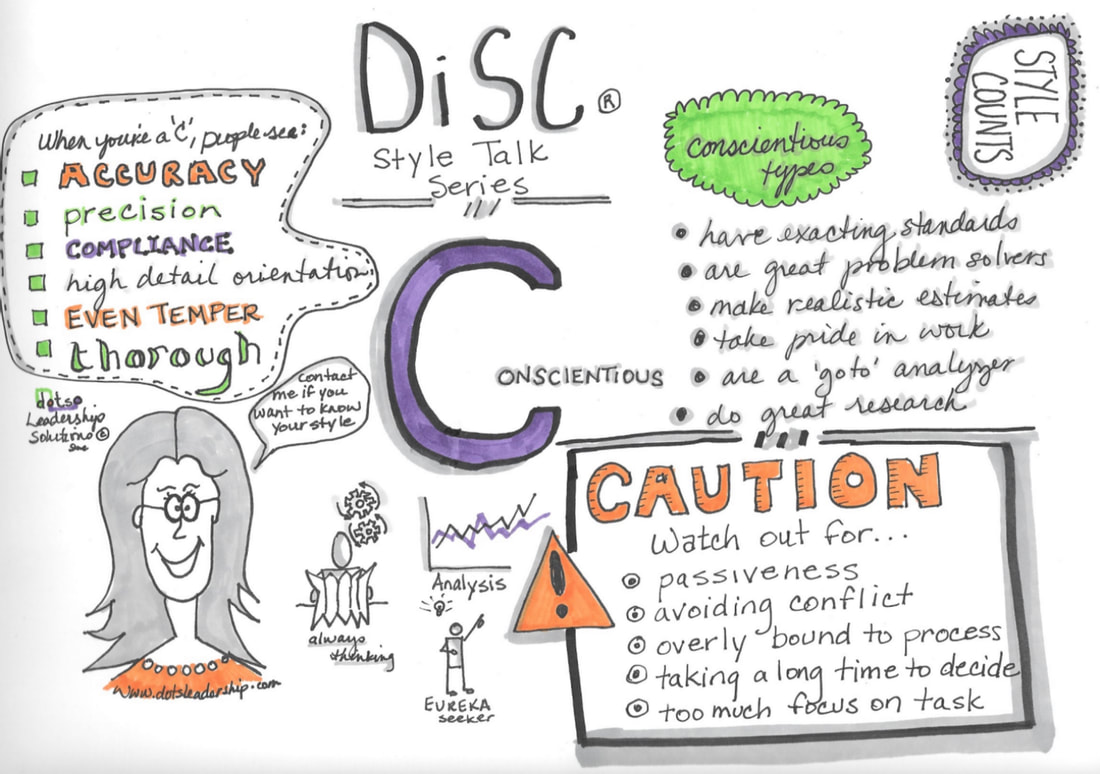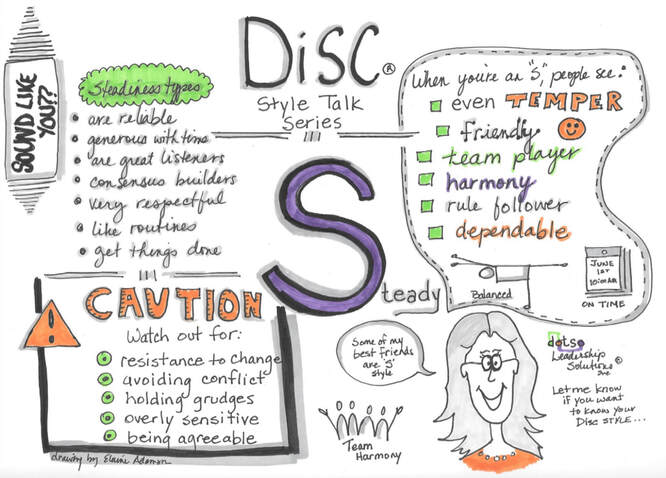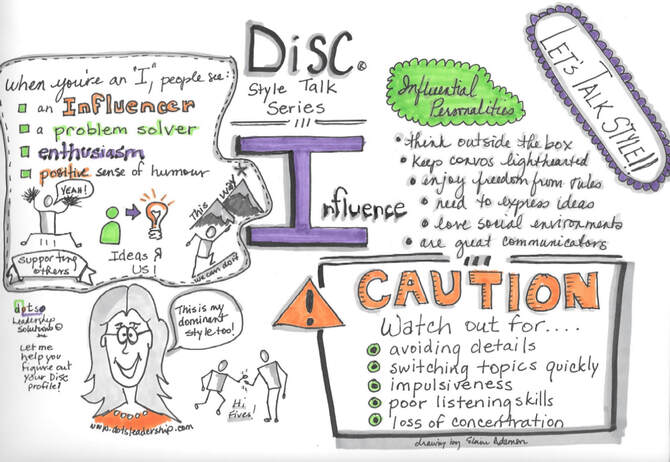With Power Comes Great ResponsibilityMy hubby and I have this ongoing joke that I am a closet cape crusader. You see I stand up for good vs. evil and I even have recurring dreams where I leap out of my car to rescue someone from a car accident. Did you ever think of yourself as a super hero? Well I’m here to tell you, that just like every defender of the universe has unique powers, so do you!
All business leaders I’ve worked with have powerful influence over others as well as many other admirable traits. The fact is that each and every people leader brings special powers to the world; it just hasn’t been pointed out in that way!
0 Comments
I get it! Difficult people on your team can zap your energy ‘getting on your nerves,’ making it a pain to work with them. Well guess what, I’m here to tell you that pretty much every difficult person you will ever lead, can be a great asset; you may even find them not so difficult after all! This series has been dedicated to helping you figure out how to tap into hidden potential of difficult types and minimize the frustration: - Part one when you’re challenged with a “The Know All” (TKA) - Part two for the blow it up Revolutionary type (TNT) or - Part three the Take No Prisoners (TNP) personality type To wrap up the series, I’m going to help you with one seldom discussed, often misunderstood and a very draining style to work with… the Constant Critic (TCC)! You know this type; they tend to be appear very negative. Just like Eeyore (from Winnie the Pooh) who constantly points out the negative in every move. They don’t cause big drama but they do seem reluctant to get onboard with anything new, usually based on some prior experience. The Constant Critic profile:
Meet Pete – “Mr. Quiet Dissonance” Pete (name changed) has an accounting background and works as a Director, Strategic Planning & Performance for a large Retailer. He's been an executive for 5 years but has been with the company for over 20. The 3 people who report to him quite enjoy working with him. He reports to Marnie (not her real name), VP Business Performance who was recently promoted. Marnie and I have been working together on improving her direct team’s collaboration and she asked for help with Pete, in particular. Pete is commonly referred to as the ‘company historian’ and has lived through a couple of mergers, several name changes as well as take over from a US-based company. Marnie was forewarned that Pete seemed disengaged before she took on the team.
Pete is a great example of the Constant Critic personality type! The good news is Pete responded positively to Marnie as soon as she began implementing strategies we spoke about. Her action plan included:
At this point, her focus is on developing more of a trusted relationship, and that maybe all it takes. Marnie's increased interest in his experience seems to have had a positive impact already; the team has noticed Pete becoming more participatory – no more crossed arms in meetings and some have even commented about him being more sociable. The benefit of having a TCC on your team – great devils advocate, can help you develop persuasive arguments, often sees a different perspective and helps to reflect on pending plans. Often they have learned from past mistakes, can be a historian with very helpful information to draw upon. The key to leading a TCC – remain positive, redirect negativity, stick to facts and data that support positive outcomes. Help them see the impact of their behaviour on others if it becomes a problem. Ask the TCC to reframe their initial reaction toward a more positive response. Caution leading a TCC – do not get pulled into negativity. Limit how much time you give when they become negative. For every difficult type of person, there is a way of changing YOUR perspective about what contribution they bring to your team. It may take a little effort, but drawing upon unique perspectives can be a competitive edge for your team. If you are dealing with a difficult person on your team (or even your boss) and you’d like help to figure out how to communicate better with them, send me an email. There are just as many strategies as there are difficult personality types! Bonus tip: Can you see a bit of yourself in Pete? Have you been 'shutting down' at work, avoiding colleagues or find yourself to be increasingly contrary? You may be a Constant Critic or are heading that way. Time to reflect on how negative you may appear to others:
Photo CC0 @bkotynski Unsplash
In part one of this series I introduced how to develop a competitive edge while leading difficult people. I began with “The Know All” (TKA) personality type. For part two I’ll focus on another challenging personality, this one is seldom satisfied with the status quo and constantly wants to make changes! The Revolutionary…. aka “TNT” Making it Right I often compare this type of person to Mike Holmes, the builder who seemingly blows up your house to fix all the wrongdoings done by previous contractors to ‘Make it Right’. This kind of person on your team can really test you, pushing at every turn with complaints about process, hand-offs, policy or people. They expect you to fix it. For the conscientious manager this TNT type is very draining to have on your team. You may pride yourself on good quality work like they do, however you’re more apt to be cautious and comfortable with subtle improvements vs high confrontation or making full-scale change. These people can be rather domineering in conversations. They have strong opinions, and even though you may see value in their suggestions, they can be tough to redirect back to work. Rather than doing battle with them, there are ways you can help to leverage their enthusiasm for the greater good! Meet Sati – the Demolition expert Lets take Sati for example (names changed). Sati works for a sales organization as a technical rep and has been there for almost 10 years. She is well liked by both peers and customers, so much so they turn to her to solve all sorts of problems. Sati has a habit of adopting other people’s issues, making them her own to solve, even when they are not in her domain. Her Sales Manager Brian really struggled to get Sati focussed on her own deliverables. Almost daily she would come to him with yet another idea to change...well…pretty much everything. Many conversations began with “Why don’t we....”, “I don’t see why I have to…”, “Why can’t x department do…”. She just constantly challenged. Brian was recently been promoted and knew Sati had some great ideas from working with her as a peer. As the days and weeks followed however, he found her increasingly frustrating to work with. Poking at him day in day out with yet another scheme she wanted him to undertake and fix, yet did not follow through on her own work. Sati is a great example of this Revolutionary – TNT difficult person. The TNT profile
The benefit of having a TNT person on your team – they are opportunistic, filled with ideas, usually very positive, they influence others, thrive on change, deal well with ambiguity and love problems to solve. The key to leading a TNT person is hearing out their ideas and giving them accountability to see changes through. Set expectations for detailed change plans outlining the risks/rewards and benefits to implementing such a change. They do best when they are heard, given meaningful accountabilities with autonomy to implement and are trusted to get it done. Caution for leading a TNT – they need a diligent leader to be available for them, not too hands on, yet someone who sets expectations, timelines then follows through. They need to be heard. The Outcome After Brian and I laid out a plan he implemented a few strategies:
In the following weeks Brian noticed a change in Sati. She stopped the incessant pushing and began to take ownership of some of the issues, working diligently to resolve. Weekly they would meet to discuss progress and Brian began to mentor her on how to look deeper into the details. Sometimes she would actually abandon an issue but not until she had more thoroughly explored it and considered the impact(s). Now Brian is well on his way to becoming a stronger leader and Sati is becoming a greater contributor, not only to the team, but also the organization. For every difficult type of person there is another way to look at what they bring to your team. It can take some effort on your part but encouraging people the right way, who previously were a pain, can actually turn into a competitive edge toward a highly productive team. Join/sign up for our blog updates (link in right margin), or visit often for other useful tips on leading people! If you are tired of struggling to deal with a difficult person on your team (or your boss) and you’d like help to figure out how to communicate with them, send me an email. I have a kit bag full of different tactics that work! Image: CC0 Unsplash @madeincartel
Recently, a client (we’ll call her Yvonne) reached out to me for assistance with a ‘know-all’ on her team. We had such great success improving their working relationship and camaraderie on the team that I decided to pass along some tips!
Many business leaders I talk to grapple with rebels or difficult personality types. Difficult people can test your every-last-nerve, yet once you figure out how to curb their behaviour by communicating effectively, you may discover a competitive advantage on your team. Over the next few blogs, I will give you tips on how to handle some of the most draining types of people:
First up is the case of Alan – The Know All (TKA) Alan – The Know All (TKA) Alan was an effervescent, spirited, high-energy team member, who was very smart. He drove people crazy with his need to be right all the time and his non-verbal, superior behaviour in meetings (like eye-rolling, arms crossed, dismissive noises). Trouble was that most days Yvonne found herself doing damage control when people complained Alan was difficult to work with. Alan spent all of their 1:1 meetings complaining about others who were unresponsive or uncooperative, inhibiting him from accomplishing his work and expecting Yvonne to set THEM right. As a result, Yvonne found Alan to be a drain on her time and energy. Due to the culminating behaviour issues, Yvonne seriously questioned whether to keep him on the team despite the great work that Alan did. After Yvonne filled me in on the many issues, it became obvious that Alan did not build rapport with others and his smug behaviour rubbed people the wrong way. So we set out a plan for Yvonne to begin providing Alan with meaningful and actionable feedback, immediately. Alan fell into the TKA-The Know All profile: The Know All profile (exhibits many of these traits)
The key to leading a TKA is to gain trust by showing them you are ‘in their corner’ but challenging them directly on their behaviour so they can see the impact of their current approach.
Caution to leading a TKA – always have your facts and data in order, never threaten or corner. Pick your battles wisely; focus on behaviour that gets in their way of success vs. labeling the person as a problem. The benefit to having a TKA on your team – this type of person has tons of relevant information to draw upon, they are hard workers, creative problem solvers, decisive, action-oriented, have high standards, are adaptive, and are highly productive. The root of Alan’s problems was that he made others feel dumb or undervalued – the more he touted his smarts, the more others did not want to work with him. They resented his approach because he never took time to value their input, he didn't create a relationship, he would talk too fast, not ask questions and express how frustrated he was in a variety of verbal and non-verbal cues. So What Happened? Once Yvonne began providing more directive feedback, Alan started making positive changes in his approach. Fortunately Alan knew Yvonne genuinely cared about his success and even though it was difficult to hear, he soon realized he came on too strong and decided to take her advice. In a few short weeks, Yvonne began to hear from others that Alan was less combative and appeared more team oriented and helpful. Yvonne is now less stressed and has improved her own skills for giving AND receiving feedback. So Difficult People or Competitive Edge? For every difficult type of person, there are ways to connect to capitalize on the strengths they bring while correcting undesirable behaviour. It can take a bit of work on your behalf but building and encouraging diverse perspectives can be a competitive edge for a high performing team! If you are tired of struggling to deal with a difficult person on your team (or even your boss) and you’d like to know how to better communicate with them, send me an email. I have many more strategies that work! Do you know anyone similar to Alan? I'd be interested to hear what strategies work for you to manage their behaviour or if you have another difficult style you struggle with - please leave me a reply below! Sign up for my blog updates (subscribe in the right-hand column) or bookmark the blog page. The next post one will feature: TNT – The Blow It Up Type – think of a ‘Mike Holmes’ like worker who sees many things that need fixing and thrives on change yet balks at routine work. Photo Credit @ergepic from Pexels Creative Commons CC0 According to Gallup State of the Global Workplace, 85% of employees worldwide are not engaged or are actively disengaged in their job. “The low percentages of engaged employees represent a barrier to creating high performing cultures around the world. They imply a stunning amount of wasted potential.” Wasted potential. How that phrase resonates with me! Death by Administration I'm sad to say, I was one of the walking ‘wasted potential’ not too many years ago. It was a dark and miserable time. My employer was doing a massive restructure, removing spans and levels of management and it was my job, as the HR lead, to implement it for my division. Unfortunately the process they undertook was more of a spreadsheet exercise, versus strategic. So the work I loved and excelled at suddenly switched from senior level advisory work to a massive load of mundane administrative tasks Every. Single. Day. , and it went on for months. This kind of work was my worst nightmare and even though it is hard to admit..I have never been very good at mind-numbing administrative work. It just wasn't the right work for me. What a complete waste! Wasted potential. People can’t thrive when they are doing the wrong work. It devalues them, misuses talents and creates unnecessary pressure. During stress-filled change, leaders can fall asleep at the helm; too busy ducking for cover, they completely overlook the signs of utter disengagement around them. Don’t waste your best resources like that; you will surely lose your highest potential people when you don’t pay attention.
Expert Lessons A great way to stem the tide of employee disengagement is to tap into the abilities of EACH and every person on your team. Get people doing the right work utilizing their best skills, long before a change occurs. According to Gallup's survey analytics it is your high potential talent that will take a walk if they are not engaged, long before the others. These top talent are the experts to learn from! Here is what top talent say will help keep them: Lesson 1
Lesson 7
Engagement Counts The best leaders demonstrate they care about each and every team member by taking an interest. They pay attention, particularly during stressful times, leveraging potential vs wasting it. They make it a practice to develop potential, all the time. They allocate work in a way that plays to their people’s strength and they keep them connected to the bigger picture. When you demonstrate YOUR engagement, harnessing the potential of your best and brightest, you are guaranteed better results for highly engaged employees. If you have a disengaged team (or team member) or are leading through stressful times and need support, I’m only an email away! I help leaders grow and develop by working with them through the toughest of times. I offer a 30-minute free consult. I want to hear from you, tell me about your own experience in the reply section below. Image: CC0 Creative Commons/Pixabay
Watching political leaders wrangle for position, launch smear campaigns and talk trash about each other sure fires up the leadership coach in me. Grown adults identified as so-called “leaders” who choose bully tactics, intimidation and demeaning others as their campaign strategy gets to me every. single. time!
The Canadian province where I live is currently embroiled in a smear-filled provincial election fraught with insults and put-downs; it is such a miserable and appalling ‘gong show’ - wish I could bong the gong to put an end to this conduct! I am not naïve enough to think anyone could simply fix what seems to be wrong with such political behaviour overnight but I hope I live long enough to witness a group of leaders stand and face the masses, clearly state their position, demonstrate what they believe in (without being wishy-washy) and then once elected, set a concrete plan working to get it done in a professional “principled” fashion. In my books, everyone in a leadership position, regardless if they’re running for office or managing a team of 2-20,000 people can be a better leader by leading with principles. My Kind of Principled Leadership
Note: Seeking, receiving and acting on feedback are skills many of us need to develop further. If you have yet to receive constructive criticism from your people about YOU, it is a good sign you have room to grow. If you have received it, consider it a great gift! Now, how did you address it?
The Core Principles in Action One senior level corporate leader I worked with (Katrina McGee….yah, not her real name) truly exemplified the core principles I look for as a Principled Leader. Such a pleasure to work with. I recall one time we were working on a very sensitive and difficult message about a pending reorganization (sadly, one of many). It was a very stress-filled period for her. She painstakingly agonized about every change to the department and fretted over each and every word choice because she personally felt the impact of the tough decisions being made – people truly mattered to her. We were working in her office around 9pm at night, long after others had gone home, when we heard the cleaner in the outer office area singing quite passionately to himself with headphones on. He passed by her door a couple of times - clearly he hadn’t noticed us but we did him. Instead of getting annoyed at the “I hope he buys you flowers” being belted out, she asked if we could take a quick break. She collected up the garbage from around her room and grabbed a fresh bottle of water from her sideboard and went to the outer office. She startled him as she emptied her bin into his cart and then took a moment to chat, giving him the bottle of water and acknowledged his singing prowess. It was obvious they had spoken before as they shared a little chuckle before she returned to the office. You see, she treated everyone with that level of respect and consideration - from the cleaner to every member of her global team to her C-suite colleagues. So genuine was her care for everyone that I can honestly say anybody who ever had the opportunity to work with her would go to the end of the earth to support her agenda. A master at Principled Leadership I would say! I know most of you want to be that kind of leader too. Here are some of the core principles that make all the difference to the teams who look to you as a leader: People Matter Principled Leaders put the interests of people first. Their every action sends a message that everyone is equal and their ideas and opinions matter. It doesn’t mean they will do everything people want, but they ensure their teams feel heard and acknowledged. Respect is Earned Principled Leaders operate with respect for others in everything they do – there is no put down, no intimidation or bullying. They gain the respect of others by treating others fairly and with respect, regardless of their position. Attitude Counts Principled Leaders have a positive attitude. They act in a positive, genuine manner, even during some of the toughest times, ensuring everyone remains calm and productive. Consistency is the Key Principled Leaders are who they are regardless of the situation. Whether riding the elevator, walking through the office or sitting in a board meeting, their every move is consistent and in-line with their good character. Curiosity is a Game Changer Principled Leaders love learning and knowing but will acknowledge openly they actually don’t know everything. They ask a million questions of people – how does that work, why does that happen, why can’t we do that, how can we make it happen. This inquisitiveness comes in handy, seldom are they duped and inevitably they know exactly who to go to if help is needed because they understand the roles/process in their team as well as other groups. Delivering is their Jam Principled Leaders are obsessed with getting done what they set out to do. They are doggedly determined. They make sure all of their team understand the mission and remain steadfast in overcoming whatever obstacles are in the way to deliver on their promises. Can you measure up to being a Principled Leader? Of course you can! You’re likely well on your way if you took time out to read this article and thought about what you currently do! Keep Dots Leadership Solutions in mind as you determine your own development needs and plans for improvement. I’d like to be your personal and confidential leadership development guide. My coaching clients will tell you I hold them accountable to deliver against any goals they set passing along many tips and tactics to help them be a Principled Leader. My style is direct (don't worry, I won't bong the gong on you), yet highly supportive and I bring 25+ years of experience working with leaders from many different industries both big and small – give me a call or drop me an email when you’re ready. Last month we focused on the letter “S” – Steadiness of the DiSC behavioural style.
This month concludes the Style Talk Series as we focus on the profile “C” – Conscientious characteristics. You may also like to review the first two parts of the series focusing on the profile "D"- Dominance, or focusing on the profile "I"- Influence. As previously mentioned, in each article I am highlighting real-life clients who tend to illustrate a strong profile of just one of the DiSC behavioural traits. You will have different degrees of each behavioural style in your own profile but you tend to have a dominant style that many at your work will witness. How you behave compared to people with differing styles to you may be quite different, even when presented with the very same scenario. Meet Nadeem (not his real name) Nadeem is an Accounting Advisory Executive with a leading professional services firm. Nadeem has traveled the world, offering advice on accounting and risk management for 15+ years and is considered a leader in this field. Nadeem has led large, matrixed teams, working on highly complex projects with large multi national corporations providing advice and guidance on Accounting and Tax.
We have identified for Nadeem that he needs to pick up on social cues and demonstrate interest in others. This includes taking a brief time in the first part meetings to greet people and chat for a moment, assess his audience then communicate in a way the other party feels valued. Nadeems’s development plan includes coaching on relationship building. Some areas include meeting preparation; helping him to assess the people he will meet so he is more prepared to make the right first impression. Also we are doing DiSC assessments with each of his direct team to help him decode their styles. Lastly he is working with an internal mentor who has the exact opposite style to his so they can learn to appreciate their differences. In future this will arm him for analyzing people and provide a roadmap for flexing his communication style accordingly. Do you know anyone like Nadeem? Or can you see yourself in his profile? He is a good representative of a strong “C” behavioural style. Can you imagine how it may benefit to you to better understand your own DiSC style and how your style may impact others? Once you see how your style affects people you work with, you can adapt accordingly. Likewise as you leverage team dynamics using DiSC assessment, you can find ways to pair people for the best outcomes as well as anticipate where friction may occur. Do you want your own DiSC Assessment? Email me to reveal the secrets of success. Everything DiSC Workplace® assessment is a great tool to use with your whole team. This assessment will decode how best to communicate for your own success. It makes a great foundational piece for business planning, improving employee engagement and team development. Not only will you receive a detailed report but I will also provide a confidential debrief that delves into your personal profile and/or team dynamic. Drop me a line when you’re ready to learn more about yourself and discuss potential career/leadership derailers so you know how to head them off! Last month we focused on the letter “I” – Influence of the DiSC behavioural style and previously we focused on the “D”.
This month we will continue the Style Talk Series focusing on the profile “S” – Steadiness behaviours and communication characteristics. As I mentioned before, the clients I highlight tend to be symbolic of a strong profile of just one of the DiSC behavioural dimensions, this month using the “S”. In your own DiSC profile you will have differing degrees of each behavioural style. That said, people at work likely have observed your most predominant one because when you are under pressure your most dominant style usually shows up. There is no perfect style, no right or wrong either; just like people are from different backgrounds, we each view a situation and react uniquely because we are approaching it from a different vantage point. This series is to help introduce the benefits of understanding your style. Meet Melissa (not her real name) Melissa is a Senior level Human Resource Business Partner for a global financial institution. Melissa has been in HR (different departments) for most of her 20+ career. She currently supports over 40 executives (various levels) who collectively have over 2000 employees. Her day-to-day work is strategic, focused on providing business executives’ HR advice, shaping and implementing strategic plans. Melissa is keen to be promoted to VP level.
We have identified that for Melissa to move up, she needs to command more authority. Colleagues, leadership and clients enjoy working with her but to be ready for the next move she has to prove she can manage conflict directly and comfortably. Showing she can stand her ground and be more direct in her communications will give senior leaders more confidence in her capabilities at the next level. Melissa’s development plan includes coaching courageous confrontation, role-playing in a safe environment using real-life scenarios and critiquing conversations. Through routine practice she will develop comfort in finding her voice, without sacrificing her strong values for harmony. Do you know anyone like Melissa? Or can you see yourself in her profile? She is a good representative of a strong “S” behavioural DiSC style. Imagine the benefit to you to better understand your own DiSC style and how you impact other people? Once you see how your style affects people you work with, you can modify appropriately. Likewise when your team uses DiSC assessment as a development tool, you will better understand the dynamic of everyone within the team. Some people may be a lot like you when others are not, you will see how to get the best out of everyone when you learn how to communicate to their style. Time for your own DiSC Assessment? Email me to reveal the secrets of success. Everything DiSC Workplace® assessment is a great tool to use with your whole team. This assessment will decode how best to communicate for your own success. It makes a great foundational piece for business planning, improving employee engagement and team development. Not only will you receive a detailed report but I will also provide a confidential debrief where we will into your personal profile and/or team dynamic. Drop me a line when you’re ready to learn more about yourself and discuss potential career/leadership de-railers so you know how to head them off! Last month we focused on the letter “D” – Dominance of the DiSC behavioural styles.
This month we will continue the Style Talk Series focusing on the profile “I” for Influence behaviours and communication style. I personally relate most with this dimension myself, though not quite to the same extreme as my client. As you will see, the client I am highlighting tends to be emblematic of a strong “I” profile which is just one of the DiSC behavioural traits. You will have varying degrees of each behavioural style in your own profile but we all have our ‘go to’ dominant style that others tend to see, particularly under stress. Two people may react quite differently when presented with the same situation, depending on their dominant behavioural style. Meet Daniel (not his real name) Daniel is a Senior Vice President for a national Sales organization that employs 4000+ people across Canada. Daniel worked his way up to a senior level over 18 years of progressive moves. He joined the company directly from University, when he began as an intern in Customer Operations gathering customer information from clients to prepare for year 2000 cut over.
For Daniel to continue to move up in the organization he must take more time to consider data and facts; use solid supporting evidence to help formulate decisions, and incorporate facts into his narrative. He is seen as a promotable resource for the business, he may be considered for President or CEO of a smaller division in the future. Daniel’s development plan includes an executive coach (external) as well as internal mentorship from the CFO, who is giving him guidance and support to develop data-driven decision making. Do you know anyone like Daniel? Or do you see yourself in his profile? He is a good representative of a strong “I” behavioural style. Can you imagine the benefit to better understand your own DiSC style and how you may impact others? Once you grasp how your style affects people you work with, you adapt accordingly. Likewise as you build a team, you can better understand the dynamic of everyone within the team. Some may strike sparks with you, yet they bring tremendous benefit overall when you learn how to communicate to their style. Time for Your Own DiSC Assessment? Email me to take advantage of the insightful perspective of Everything DiSC Workplace® assessment or to arrange a session with your whole team. This assessment will decode how best to communicate for your own success. Not only will you receive a detailed report but I will also provide a confidential debrief where we will delve into your personal profile and/or team dynamic. Drop me a note when you’re ready to learn more about yourself and discuss potential career/leadership de-railers so you know how to head them off! Sitting together at a big oak table, in her spacious corner office on the 24th floor overlooking Bay and Wellington Streets in Toronto, my well-respected client asked me to help her map out the next steps in her career. She felt stuck; almost embarrassed that she was misaligned to her career after all it took to get there. Proof that even when you reach the coveted C-suite, you can still feel discontented or unfulfilled in your job. Most people associate their sense of self and identity with the work they do and paycheque they make. You can see how difficult it would be to determine where to make the next move when you find yourself in this situation. Where to Begin I often suggest watching a TED Talk by Adam Leipzig, called How to Learn Your Life's Purpose in 5 Minutes. One of most popular TED Talks of all time, with more than 8.5 million views. In less than 10 minutes Adam provides 5 key questions to help identify your life’s purpose. It’s a great start to expanding your view on what you should do to give you fulfillment. I use a variety of introspective tools as well as questioning techniques with my clients. If you feel stuck, or in a fog you’ll find a snippet of questions below that can begin to clear your view. This reflective exercise activates ideas, narrowing in on clues you can use to reimagine a more rewarding career or job. Your Calling Many of us are forced to make life-long choices selecting education specialties or career direction with minimal information about who we are and what we are best at. Seldom are we given tools to help identify what path to take. Caught up in the tsunami of life and career, it sweeps you along without much time for reflection. In fact, sometimes it takes years of doing the wrong thing before it really dawns on you that you’re way off base! Few can afford to leave their job to experiment and dabble in other fields to figure out where the right place is; instead you need a solid plan with a process to follow. What I’ve found best is to carve out time for self-reflection and introspection. Then seek feedback and dig into your strengths, doing this opens you up to connect with your calling. YOUR CALLING = the intersection between doing what you love and the ability to make money doing it! Who AM I Really? The answer to the right place for most people is typically tied to who they are and have always been. There are trails of evidence that you can relate to when you go through this exercise. Similar to Adam’s Ted Talk these questions help you uncover what you’re meant to do.
Connect the Dots While it seems a simple exercise, this reflection actually takes work to gather and time to contact and listen to as many people as you can. It is vital that you remain open to hear feedback without judgement. Take notes, ask clarifying questions and avoid judging or defending. I always say feedback is a gift! So just accept whatever points people share and say thank you, graciously. Armed with this information, you will find some obvious clues to connect the dots for what you are meant to be doing. The key to success in the future lies in leveraging your very best traits and skills while focusing on areas you’ve had the most enjoyment and impact to others. Impact to others is a crucial piece of data few ever collect. Service to others, or making a positive impact is a critical building block to most people’s work contentment. From here brainstorm, look at what you can change in your current job to better align with your purpose. But also look for project work, roles, departments, or other industries and your network for potential opportunities to consider. The path isn’t always immediately obvious. Some people stay within their job working on the side with charities, volunteering or mentoring others or contributing to the greater good in other ways. Craft an action plan to network further, identify potential jobs that leverage what you’ve done so far, look at independent work or other businesses where you can fully utilize all that makes you unique. If you find yourself struggling in a job that leaves you feeling undervalued, and want assistance from a leadership coach to help guide you , provide feedback and gain clarity with accountability to follow through, please send me an email! Or if you’d like to delve deeper into who you are and what makes you tick, please reach out. It would be a privilege for me to help you find work you love! Photo: Creative Commons Zero (CC0) license
Hire The Right Person FastIf you’re like many of my clients, you have probably posted a job to fill, only to find yourself sifting through 200+ UN-qualified applicants.
With the likes of Monster, Indeed and Career Builder simplifying the job hunting process has made it easy for what I call 'serial job seekers' to blast out applications to a mass number of postings without even reading the full job posting. But this doesn’t help you—you need to find the ‘right’ person to without wasting your time! This means you need to be extra diligent in your quest to hire, in order to reduce the number of serial job seekers you encounter. To help you find the right fit for your new role, follow these top 5 tips… You’ve been there–it could be a pain-in-the-butt colleague, a trouble-making employee, or worse, a devil-boss who makes your workday absolute torture! Regardless of who they are, they likely all have this one thing in common…nasty bullying behaviour. Sadly, if you don’t find ways to manage it, the stress may cause your health to decline, you disengage from work resulting in your performance taking a hit or you have the sudden urge to quit because you simply have no other way out. Dealing with a workplace bully wears us all down. Repeated over time, you may actually believe what they say, sparking self-doubt and eroding your self-esteem. They yearn for this power and as such, once they’ve set their sights on you, they do what they can to take you down. I’ve helped several clients rise above these difficult people. It takes a little bit of work but in the end, they feel a sense of accomplishment once they triumph! It’s important to note that if what you are dealing with is an extreme case of bullying or a possible harassment case, there are Human Rights laws to protect you. Handling those situations requires a formal process. The Ministry of Labour (Ontario) provides guidance to both employers and employees regarding these laws in my province. What I’m talking about today are the scenarios where someone is staying within the bounds of the law, but making it unpleasant for you to work with them. These people know how to get at you but management may not see it, may choose to ignore it, or it just may not be bad enough for you to want to raise a big fuss. The Bully ProfileThese nasty people often share similar characteristics, they:
So what CAN you do to battle this kind of unpleasantness? Lets look at some simple tactics to disarm these bullies and take back your own power:
1. Let them shine It may seem counterintuitive but people who are problematic are typically seeking some kind of attention. Take time to assess this person’s underlying insecurity; ask yourself the following questions to become aware of what is really going on:
With this information in mind, look for a moment to praise them when they do something you can comfortably acknowledge: “Jane had a good point”, “Jane was absolutely right, ‘Thank you Jane for xxx” “Jane I quite liked xxx”. These comments begin to neutralize their need to be nasty because their own esteem rises. However, it’s important that you approach this genuinely. Don’t do it if you don’t really feel it or it will come off as disingenuous and inflame them further. Giving them the limelight is a powerful tool and it works in most situations. 2. Use the power of Aikido If you haven’t heard of it before, Aikido is actually a form of martial arts. Yet, it is non-threatening and doesn’t use force. In fact, what makes Aikido so effective is that it removes aggression from an adversary by yielding to his/her force in a way that they end up only hurting themselves. For instance, imagine stepping out of the way as someone tries to strike you–the attacker would likely fall down, hurting only themselves. Mean people are easily unsettled when you DON'T react the way they are expecting. Because most of these people have very low self-esteem, their actions come from a place of insecurity; they lash out or belittle to make themselves feel better. To use an ‘Aikido-like’ reaction:
3. Find your inner comic Instead of letting these people get under your skin, find a way to make light of their behaviour. I have seen really great leaders deal with some very annoying people simply by making a quick thinking remark. For instance, in the case of an employee continuously interrupting a meeting, the leader might say, “Slow down there speedy, I’m driving this meeting”. If it’s your boss who’s pushing your buttons, this can be a bit trickier but you can still make light of their nasty comments. Laugh out loud and say something like, “Oh, for a moment I thought you were calling me an idiot–that’s a good one”. It may not immediately come to you in the moment, so after an interaction has happened, consider things you could say next time. The AMA has a great article on how to have the last laugh, worth a read! Try to avoid insults as you don’t want to stoop to their level–I’m talking about making light of their comment so you take back control. 4. Call them on the behaviour We naturally try to defend ourselves or strike back when mean people put us down or make a condescending comment. These people have become experts at making others look second-rate so that they can feel superior. That is where they draw strength. If you can’t ignore their comments, respond firmly with a response that exposes the behaviour, “That sounded like a put-down”. It usually holds a mirror up to the individual and catches them off guard. Most of these people won’t want to ‘look bad’ in front of others and a public call-out will make them uncomfortable enough to switch gears. Over time, this tactic can actually help them with their own self-awareness. 5. Nip it in the bud: stage an intervention This approach takes a great deal of courage and I recommend doing this with support. Book a face-to-face meeting with the difficult person and address their behaviour head-on when you are cool-headed. Be sure to have several specific examples at the ready. Make sure your discussion is done in a way to help them understand the affect they have on others. Conduct this meeting in private; clarify what the issue is as factually as possible and set out a plan to fix the problem offering support and guidance. Let them know how these behaviours are making you or your team feel. Use ‘I’ or ‘I feel’ messages. For instance, “I feel embarrassed when I’m called out in a meeting in front of others”, or, “I feel disrespected when I am constantly interrupted in meetings”. ‘I feel’ messages usually resonate better because the other person is not put on the defensive–no one can deny your own feelings. If you have internal HR support, they can assist you in this discussion. If not, then consider bringing in external support to help you plan this discussion and to be present during the meeting. Don’t let nasty people ruin your work experience. Approach them as though they have a problem and don’t let it be your problem anymore. Typically they have developed this behaviour over many years but no one has called them on it. It is possible for them to change, but it takes work on their behalf as well as yours. Most great companies have formal policies to reinforce values for treating people with respect. This is great for employees, but what about you as a leader? Check out our additional posts that deal with bad behaviour like bullying at work: - 6 Strategies for Dealing with Difficult People - Difficult People or Competitive Edge - The Constant Critic - Difficult People orCompetitive Edge - Take No Prisoners If you’re dealing with colleagues or team members who are disrespectful to you, I’m here to help. I can arm you with proven practices to help you manage through the tough stuff. Send me an email or give me a call today, I offer a 30 minute free consultation! I can’t tell you how many times I’ve been asked, “should I promote from within or hire externally?” And while I wish there was a quick way to answer this question, there simply isn’t.
When this conflicting decision arises, there are several factors I look at, and recommend my clients consider, to help decide and prepare accordingly. For the most part, hiring from within is seen as a very positive practice. However, if you promote the wrong person, missing the right skills and attitude, you will have upheaval as a result. Likewise, introducing an external hire into the team can bring forth new ideas, fresh thinking and objective perspective. But if the rationale for going external is not understood by the team, and people feel overlooked the person can be rejected pretty quickly–particularly in a tight knit group with an aversion to change. Either way, hiring the wrong fit for the role or the team may lead to:
Taking time to consider the right type of people you need, who fit your environment, share the same values as the team and have the right skill set, is the key to determining whether to promote from within or hire externally. To prevent bad feelings, it is very important to consider internal staff first in your selection process before going outside of the business. To help you learn from other’s experience, I’ve highlighted some scenarios that underscore the pitfalls of in-house promotion vs. external hire. Scenario #1 – Internal Hire Meet Tony Saildude. Tony was a National Sales Director in an ever-changing, fast-paced company that was trying to acquire market share in a highly competitive industry. After his Sales Manager, Joyce Leadcraft left the company to stay at home with her 4 young children, Tony suddenly had an opening in their small business sales division. Over several years, Joyce built the team from the ground up and was always there to ensure deals made it through in a timely manner. She continuously answered policy and process questions and effectively stickhandled internal conflict with both Marketing and Operations. Acting quickly, Tony decided to select his best salesperson, Ron Sharp, for the role. Ron was well liked by the team and senior leadership, always upbeat, a great relationship builder and had been in his role for 4 years, frequently attaining the pinnacle of CEO Sales Club annually. Ron was delighted with the promotion. He received a handsome increase, a parking spot and the coveted ‘inside office’. But shortly after he was promoted, the complaints began rolling up to Tony from the team. Ron wasn’t available like Joyce had been and he didn’t take the time to solve internal issues. He usually took long lunches or breaks and frequently was seen socializing with people in Marketing. Ron was also bossy to the team, barking out deadlines and often raised his voice before closing himself in his office. And when they had internal issues with other groups, he would say things like “suck it up buttercup” leaving them frustrated and resentful. Ron’s greatest strength had always been building rapport with customers, but in his new role, he was stuck in the office all day, forced to stick-handle a myriad of questions and expected to answer to Tony–it was not a good fit for Ron. What Tony really needed was someone who could run interference internally, communicate clear direction, hold others accountable and also be readily available to resolve issues. These were skills and strengths Ron just did not have. The Learning: Questions When Promoting Internally
Scenario #2 – External Hire Meet Mary Newhere. Mary was the new Senior Vice President, Human Resources for a financial services company. The department was built on a foundation of promotions from within the company, so much so that many of the existing HR department did not have HR experience, which was why they hired Mary. Seeing that the business was about to go through quite a bit of change, Mary wanted to hire a successor who could navigate the impending transformation, so she decided to hire externally. She hired Laura Right. Laura had a 25+year HR career from different industries and was highly recommended through Mary’s network. Soon after she joined, Laura realized how tight the current team was and while they really liked her, she found that they rejected any new ideas or suggestions, even though Mary was always supportive. Two months after Laura was hired, Mary was moved to another position and Laura’s new boss became Lester Oldschool–a financial services ‘lifer’ who navigated several departments over his 30 years and was a sceptic about new ideas that may impact the culture. Laura’s peers adored Lester, complaining to him that Laura was hired too quickly and that none of them were even considered for the role. They weren’t happy that she wanted to make change to ‘tried and true’ practices. It wasn’t long before Laura became discouraged and frustrated. She had no other sponsor or support once Mary left. Although her business clients thought she was refreshing, she was unable to affect change in HR and constantly faced a battle. Laura left before her 2-year anniversary after being snapped up by another company. The Learning: Questions When Hiring Externally
Trying to decide between promoting internally versus hiring externally can be a challenge. To avoid creating an unhappy environment, remember to consider your internal staff first, measuring them appropriately against the requirements of the role, before going outside of the business. Hiring the right person and ensuring that they’re successful in their role requires careful consideration and planning. If you need assistance or guidance in this area, contact us to help you assess your environment and needs. Dots Leadership Solutions also offer pre-screening or second interview support, custom recruitment frameworks and custom tool kits to assist leaders in making the right hiring decision. How to Deal With Difficult People On Your TeamOne of the most frustrating and time-consuming aspects of every manager’s role is dealing with a difficult person on their team. But getting good at managing the most challenging employee can be well worth the time and effort invested, even if it doesn’t seem it at the time. Not only will you demonstrate top-notch leadership skills to ‘the powers that be’, but you’ll also be role modelling for those you are developing to be a leader – which looks great on you! There are all kinds of difficult people to manage or to work with: the know-it-all’s, passive-aggressive’s, quiet sulker’s, loud mouths, pity partier’s etc. And while you can develop specific strategies for managing each type, I have found there are a few general approaches for dealing with ANY difficult person that are often successful: 1. Understand Your Own Type I know what you’re thinking…’Hey, I’m not the one who is difficult, so why start with me?’ Well, that is because when you understand yourself, you can better strategize how to flex your style to effectively communicate with others. It also helps you recognize why some people drive you to the brink and press your buttons more than others. There are many assessment tools that can be used to develop a greater understanding of your own personality type and how you affect others. DISC, Kolbe and Myers Briggs are quite common and a good place to start; it doesn’t matter which tool you use as long as you do the homework on self-discovery. 2. Understand Each Of Your Team Member’s Type Unsurprisingly, I also recommend understanding the personality type of each of your team – not just the difficult one! Teams are like living organisms; they have reliance and dependency on one other. People get along much better when they learn to appreciate the nuances and differences of each other. Personality assessments provide a non-threatening, consistent language that facilitates the breaking down of communication barriers. 3. Be CANDID! This is not for the faint of heart. Being clear and candid with a difficult person is not easy for most people, yet it is the single most important first step in managing the situation. Regardless of the different types of ‘difficult people’, when you can articulate the issue head on, you’ll make better progress. Help them to understand how their behaviour is impacting the office, the team or any key stakeholders. Good ol’ Dr. Phil says, "You can't change what you don't acknowledge", and that holds true here too. You have to call out what the problem is, particularly when it is causing trouble with others. The way to do this is by clarifying the effect the person’s behaviour is having on others without judgement and blame. A great reference for how to frame these conversations is a book called Crucial Confrontations. Just as the title implies, confronting is crucial! Regardless of how awkward the situation, when you deal with it with compassion and the right intentions, you can work with the person to find solutions. 4. Look For An Underlying Issue I’m not saying you should give them an excuse for their ‘difficult-ness’, but you may find that something may be at the root of their behaviour issues and knowing this will give you a clue for how to manage it. I once worked with a man who, when heard on the phone with his wife, was clearly in a dictatorial relationship – he was a doormat at home, but a tyrant at the office! Once we realized that he had a need to feel in control because he had zero control outside of work, we were able to adapt how we dealt with issues to give him some measure of power within his work. Very quickly, he stopped battling everyone else. Simply put, if you can spot the underlying issue, you can adapt your response. It takes a little thoughtfulness, but it absolutely works. 5. Tap Into Empathy Sometimes you have to walk in someone else’s shoes to understand where they are coming from. Try to put yourself in their situation to understand their point of view before jumping to conclusions. Did you know CCL research shows that, “Managers who show more empathy toward direct reports are viewed as better performers in their job by their bosses.” In today’s social media rich world we are terribly quick to label a difficult person and criticize before taking time to understand who they are and how they view life. In the workplace, it is a big win when you can find the bridge into their way of thinking – you can then help by making a connection and break down the issues. 6. Accept 100% Responsibility For Your Response I often say, no one can make you FEEL anything – how you choose to respond to any tough situation is all up to you. The fact that someone is driving you crazy is a direct reflection of how you are responding to somebody else’s ways. This is completely within your control. This is a tremendously liberating concept when you realize you have the ability to control your response. Brian Tracy - Free Your Mind: How You Are Responsible offers a great snapshot for just how to accomplish this! When it gets really tough dealing with a difficult person and you are about ready to give up or you’ve been trying to follow HR guidance and still not getting at the heart of the matter, give Dots Leadership Solutions a call – we have a kit bag of approaches that have worked very effectively. We also have some great assessment tools and can be available to plan for or facilitate discussions if you need an objective third party! Image from Pixabay CC0
|
Most Popular Posts:
AuthorElaine Adamson is a leadership consultant with Dots Leadership Solutions Inc. A natural dot connector. Passionate about coaching team effectiveness and leadership development she shares over 25+ years of real-life tips and tricks that really work! 
Elaine believes you can discover and leverage strengths to forge a strong team dynamic despite business challenges or organizational change.
She posts some great articles on Linked In too! Topics of Interest
All
Archives By Date
November 2022
|
Specialties |
Company |
|
















 RSS Feed
RSS Feed